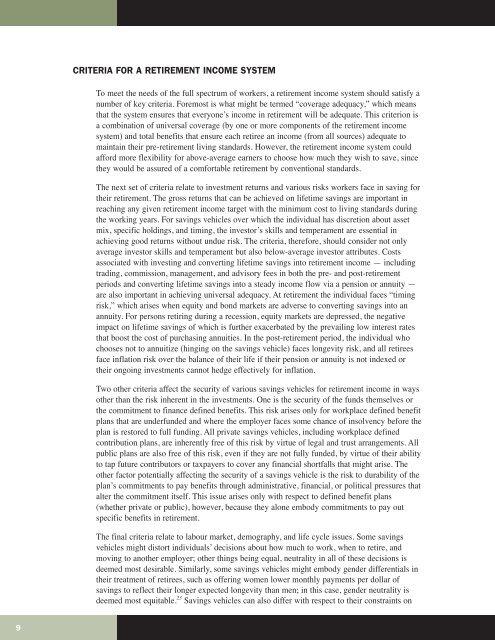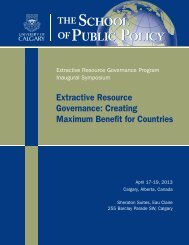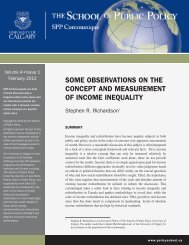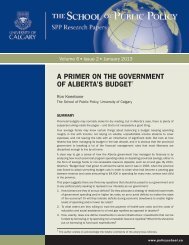EXPANDING CANADA PENSION PLAN RETIREMENT BENEFITS Assessing Big CPP Proposals
EXPANDING CANADA PENSION PLAN RETIREMENT BENEFITS ...
EXPANDING CANADA PENSION PLAN RETIREMENT BENEFITS ...
You also want an ePaper? Increase the reach of your titles
YUMPU automatically turns print PDFs into web optimized ePapers that Google loves.
CRITERIA FOR A <strong>RETIREMENT</strong> INCOME SYSTEMTo meet the needs of the full spectrum of workers, a retirement income system should satisfy anumber of key criteria. Foremost is what might be termed “coverage adequacy,” which meansthat the system ensures that everyone’s income in retirement will be adequate. This criterion isa combination of universal coverage (by one or more components of the retirement incomesystem) and total benefits that ensure each retiree an income (from all sources) adequate tomaintain their pre-retirement living standards. However, the retirement income system couldafford more flexibility for above-average earners to choose how much they wish to save, sincethey would be assured of a comfortable retirement by conventional standards.The next set of criteria relate to investment returns and various risks workers face in saving fortheir retirement. The gross returns that can be achieved on lifetime savings are important inreaching any given retirement income target with the minimum cost to living standards duringthe working years. For savings vehicles over which the individual has discretion about assetmix, specific holdings, and timing, the investor’s skills and temperament are essential inachieving good returns without undue risk. The criteria, therefore, should consider not onlyaverage investor skills and temperament but also below-average investor attributes. Costsassociated with investing and converting lifetime savings into retirement income — includingtrading, commission, management, and advisory fees in both the pre- and post-retirementperiods and converting lifetime savings into a steady income flow via a pension or annuity —are also important in achieving universal adequacy. At retirement the individual faces “timingrisk,” which arises when equity and bond markets are adverse to converting savings into anannuity. For persons retiring during a recession, equity markets are depressed, the negativeimpact on lifetime savings of which is further exacerbated by the prevailing low interest ratesthat boost the cost of purchasing annuities. In the post-retirement period, the individual whochooses not to annuitize (hinging on the savings vehicle) faces longevity risk, and all retireesface inflation risk over the balance of their life if their pension or annuity is not indexed ortheir ongoing investments cannot hedge effectively for inflation.Two other criteria affect the security of various savings vehicles for retirement income in waysother than the risk inherent in the investments. One is the security of the funds themselves orthe commitment to finance defined benefits. This risk arises only for workplace defined benefitplans that are underfunded and where the employer faces some chance of insolvency before theplan is restored to full funding. All private savings vehicles, including workplace definedcontribution plans, are inherently free of this risk by virtue of legal and trust arrangements. Allpublic plans are also free of this risk, even if they are not fully funded, by virtue of their abilityto tap future contributors or taxpayers to cover any financial shortfalls that might arise. Theother factor potentially affecting the security of a savings vehicle is the risk to durability of theplan’s commitments to pay benefits through administrative, financial, or political pressures thatalter the commitment itself. This issue arises only with respect to defined benefit plans(whether private or public), however, because they alone embody commitments to pay outspecific benefits in retirement.The final criteria relate to labour market, demography, and life cycle issues. Some savingsvehicles might distort individuals’ decisions about how much to work, when to retire, andmoving to another employer; other things being equal, neutrality in all of these decisions isdeemed most desirable. Similarly, some savings vehicles might embody gender differentials intheir treatment of retirees, such as offering women lower monthly payments per dollar ofsavings to reflect their longer expected longevity than men; in this case, gender neutrality isdeemed most equitable. 23 Savings vehicles can also differ with respect to their constraints on9








